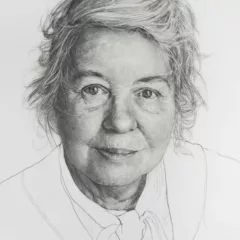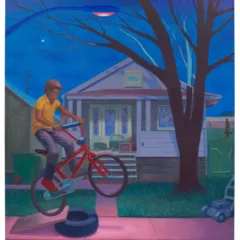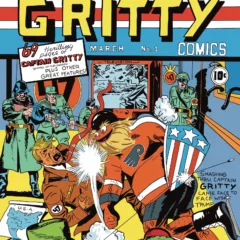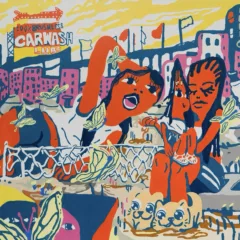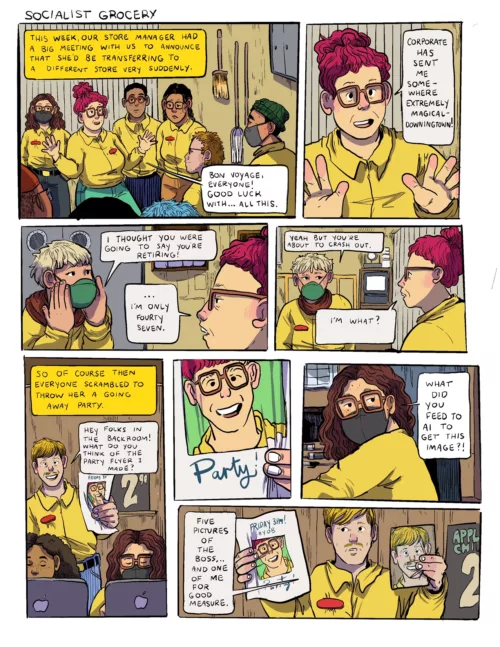Heet Lee and I studied together at the University of the Arts, and I’ve been a lucky witness to her evolution; she has a ferocious ability to manipulate materials, and constantly adds new processes to her tool box. Last month, I traveled to Germany to see her first solo exhibition, AXIO, at the Museum der Bildende Künste Leipzig (November 15 – December 9). The work in this exhibition is a combination of screen printing, painting, collage, and photography — all brought together with an adversarial, aggressive logic. Posters are torn from walls, paint is applied to obliterate.
Since graduating, this Philadelphia-based painter has found a second artistic home in Leipzig — first through the Pilotenküche residency program and again at the Museum der Bildende Künste. AXIO is part of the museum’s “Connect Leipzig” series, which gives young artists their first solo museum exhibition; the only stipulations are a personal connection with the city and a body of new work.
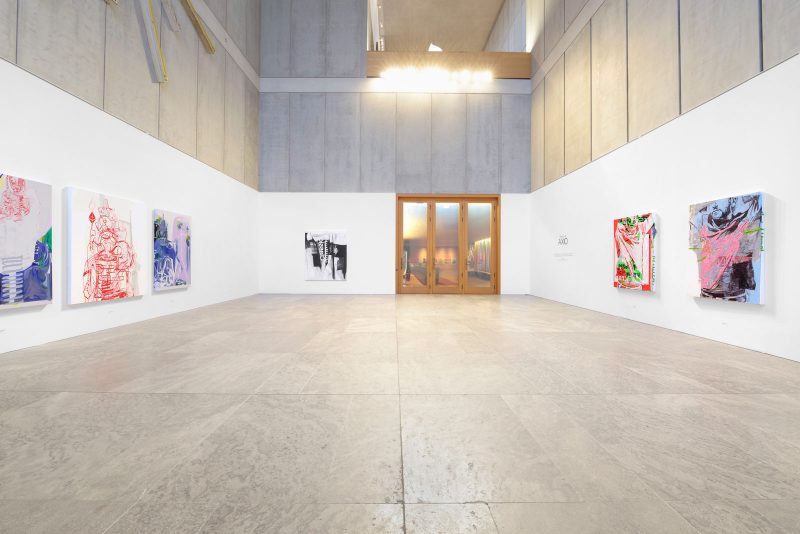
Three kings
For Heet Lee, naming is an act of autonomy. Like her own name, AXIO is a word of her invention. It was chosen in part because she likes the way it sounds, but it has other, fitting implications. Like an axis, the act of painting (and the structure of a stretched canvas ground) is the through line of this work. Around it revolve her myriad subjects and sources, which run the gamut from discarded commercial packaging to portraits of her partner and from 17th century Czech sculptures to airline infographics that demonstrate life vests — “JERK TO INFLATE.”
Heet Lee combines these last two subjects in the three paintings titled “Wenceslas” (2018), “Charles IV” (2018), and “The Throne” (2018). Here, statues of seated kings from Prague are nearly erased, surrounded by floating symbols of cryptocurrency and carved up with gestural drawing. It’s a Francis Bacon-esque destruction of art historical precedents, though with less drama and more jokes. Are these old sculptures and old cultures in need of rescue, or are they jerks, inflated? There are no clear answers here, but their open-ended contents feel satisfyingly deliberate with her concrete touch.
Subtle humor and painterly joy
Even in school, Heet Lee was inspired by German painters such as Sigmar Polke (1941-2010) and Albert Oehlen (born 1954). Polke had a post-war skepticism for authority — ironically invoking fault lines in the perceived value or truthfulness of his wide-ranging materials and subjects. Oehlen, an abstract painter of a more earnest ilk, creates according to self-imposed rules, indulging in expressionist marks and incorporating collage. His systems of production result in paintings that cohere in a logic of his own making rather than referencing external narratives or aesthetic traditions. Heet Lee’s work is also guided by a scaffolding of pre-established systems. Like Polke, her work is punctuated by an energetic discontent — and maximal use of appropriation. The humor here is coded, but reveals itself in subtle, surprising ways. “Brütto für Netto” (2018) is the largest, most glamorous painting in the entire exhibition, and it’s a bloated chip bag that attains strange sex appeal. If it weren’t for the barcode and text, its ghostly folds would resemble a bedspread. Another painting follows a similar formula — “Für Sie Drin” (2017) turns a billboard of a barcode into a moment of painterly joy.
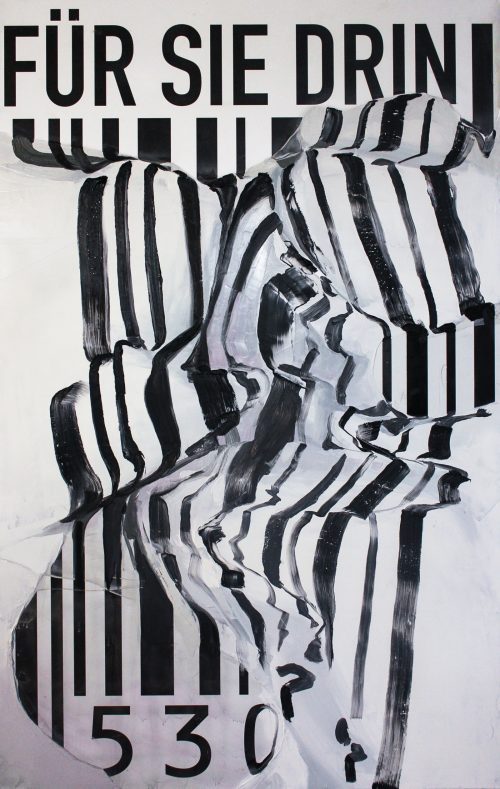
Public works
Walking around the city of Leipzig, it’s immediately evident how her artwork so seamlessly slipped into the fabric of this place. It fits like a glove. The city is peppered with graffiti that, embraced rather than rejected, behaves like public mural-making. Posters for everything from rideshare apps to Rammstein concerts are wheat pasted into thick palimpsests. Culture has a physical, analog presence here.
With AXIO Heet Lee excavates these sources. There are nine large canvases in the gallery, each a stage for action. There’s athleticism in these paintings, an aggressive energy. Posters torn from walls are pasted directly onto canvas, and large strokes of paint seem slapped on, though secretly careful; the weighty surfaces of her works become like extensions and contractions of the world outside this gallery. Yet these paintings are also glimpses into her life. Objects both intimate and common are thrown together and sifted through her lens of irreverence; hers is a knack for finding a diamond in the rough.

Materials become adversaries
From Kurt Schwitters to Wangechi Mutu, the great collagists of modern and contemporary art have often exploited the medium’s formal potential. Images and materials are selected because they aesthetically fit and disparate elements come together to create a logical pictorial whole. Heet Lee’s collages adhere to a different strategy in which materials are never used decoratively. Rather, she treats them as adversaries, subjects to be defaced, distorted and defamed. The resulting works hover in a curious space between the images they once clearly possessed and the violence enacted upon them. “Aphixxx” (2017) and “Johnny-24” (2017) are portraits of her partner, but even these images are no exception; in these works, a male figure is embedded into found posters, but it’s hard to see where he begins and ends. Readability becomes a game. Each painting emerges as a victory over things her eyes have consumed.
“AxioCert” (2018) is the painting that ultimately brings together the many elements of this exhibition; here, a huddled, infant-like figure with devil horns (drawing from contemporary sculptor Jaroslav Rona’s “Sedící čert”) is wrapped in large text, and sits with the image of a car resting on its head. Closer looking reveals it to be painted on a poster advertising a ride-share app, and I immediately recall Heet Lee’s trio of seated kings: the painting shuffles History and Art with its inevitably contemporary, digital, consumerist context. Yet there’s more at play in this painting — a pensive, anxious, mood that pervades the lemon-lime palette. This sitting devil stares at a wall, alone, mired in the vestments of advertising. Here is a sense of loss, at once comical and poignant. I’m reminded of the legend of William Tell, who shoots an apple off his son’s head — this figure too seems poised on the edge of an ending.

“AXIO,” a solo show by Philadelphia artist Heet Lee, was on view at the at the Museum der Bildende Künste Leipzig from November 15 – December 9, 2018.


